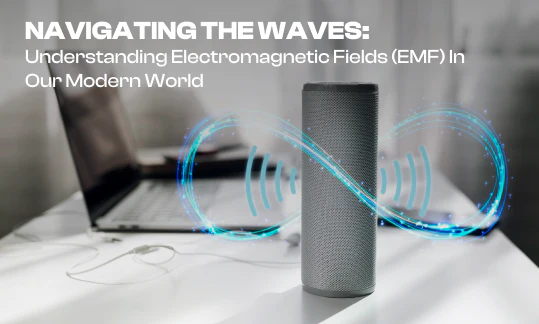In our increasingly interconnected world, the invisible force of electromagnetic fields (EMF) surrounds us, powering our devices and enabling communication. While these fields play a crucial role in modern technology, concerns about their potential impact on human health and the environment have also emerged. This blog aims to shed light on EMFs, exploring their sources, types, the ongoing debate surrounding their safety, and solutions to mitigate exposure.
Understanding Electromagnetic Fields:
Electromagnetic fields (EMFs) are a combination of electric and magnetic fields that are produced by the movement of charged particles. These fields are present everywhere in the environment and are generated both by natural sources and human-made devices.
Natural sources include the Earth’s magnetic field, which plays a crucial role in compass navigation, and cosmic radiation from the sun. Man-made sources, on the other hand, encompass a wide array of technologies, from household appliances and power lines to wireless communication devices like cell phones and Wi-Fi routers.
EMFs can be categorized based on their frequency or wavelength into two main types: ionizing and non-ionizing.
Ionizing EMFs:
- High-frequency EMFs with enough energy to remove tightly bound electrons from atoms, creating ions.
- Examples include X-rays and gamma rays.
- Ionizing radiation is used in medical imaging, such as X-ray examinations, but it also poses potential health risks due to its ability to damage biological tissues and DNA.
Non-ionizing EMFs:
- Lower-frequency EMFs with insufficient energy to remove electrons from atoms, thus not causing ionization.
- Examples include radiofrequency (RF) radiation, microwaves, infrared radiation, visible light, and extremely low-frequency (ELF) fields.
- Non-ionizing radiation is commonly produced by everyday electronic devices, such as cell phones, Wi-Fi routers, power lines, and household appliances.
EMFs play a crucial role in various aspects of modern life, including communication, technology, and medical applications. However, concerns have been raised about potential health effects associated with prolonged exposure to certain types of EMFs, particularly those in the non-ionizing range. Research is ongoing to better understand the biological effects of EMFs and to establish guidelines and regulations to ensure safe levels of exposure.
Impact of Non-Natural EMFs on Health:
Research suggests that exposure to higher frequencies, such as those emitted by 5G, can have various health implications. From influencing wound healing rates to triggering changes in adrenaline levels and brainwave patterns, the impact of non-natural EMFs on our well-being is a growing area of concern.
Studies have shown that exposure to EMFs can lead to DNA damage, cell death, and potentially contribute to cancer development. In fact, some argue that the health risks associated with EMFs are comparable to the hazards of smoking.
Unlike other environmental risks, EMFs are invisible, making it challenging for individuals to gauge their exposure. As our world becomes increasingly carpeted with appliances, electric cars, and satellites, the pervasive nature of EMFs leaves us questioning how to navigate this invisible threat.
Solutions for Safer Living:
Acknowledging the omnipresence of EMFs, it becomes crucial to find ways to mitigate exposure. Here are some practical tips:
1. Control Your Devices: 80-90% of EMF exposure comes from your own devices. Put your phone on airplane mode or turn it off when not in use. Avoid constantly keeping it in your pocket, especially near reproductive organs.
2. Manage Wi-Fi Usage: Turn off your Wi-Fi at night to reduce exposure. Consider using timer plugs for electronic devices.
3. Connect with Nature: Spending more time in nature, whether it’s a forest, by the ocean, or simply walking barefoot on the earth, can help reduce the damage caused by EMFs.
4. Use EMF-Reducing Technologies: Explore technologies designed to shield or limit the impact of EMFs on the body, such as Waveguard Devices.
Waveguard Devices:
Waveguard devices work by depolarizing the man-made EMFs in our environments to significantly reduce EMF radiation. While natural EMFs are not polarized, man-made EMFs are. Exposure to these polarized EMFs can adversely affect every cell in the body, posing health risks at various levels.
Waveguard devices transcend the typical claims of EMF protection, standing firmly on a foundation of robust scientific research that substantiates their efficacy. An independent study highlights the capability of Waveguard devices to depolarize up to 90% of the harmful radiation emitted by mobile phones. This translates into a significant reduction in the risk of cellular damage and other detrimental effects on the human body.
With the Qi-Shield for portable protection, the Qi-Home for home protection, and the Qi-Max for robust protection, Waveguard offers a comprehensive lineup that caters to various lifestyles, ensuring that individuals can safeguard their well-being from harmful electromagnetic radiation wherever they go.
Learn more and explore Waveguard products here!
Personalized Solutions:
Depending on your lifestyle and living space, different levels of protection may be necessary. From personal solutions for travel to comprehensive strategies for larger homes or corporate high-rises, tailoring your approach to your specific environment is key.
As we continue to navigate the challenges posed by the ever-expanding reach of EMFs, awareness and informed choices become our most potent tools. By adopting simple lifestyle changes and embracing technologies that promote safer living, we can strive to maintain a healthy balance in our technologically-driven world.
Learn more about the potential dangers of EMFs, the truth about 5G, and simple hacks to protect yourself with Pavel Stuchlik and Hagen Thiers, founder of Waveguard here!

